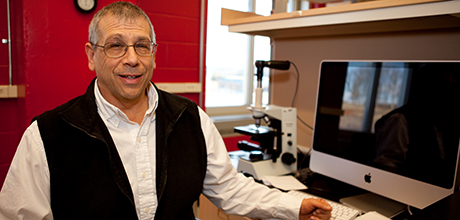Chemistry Professor Stuart Licht will continue to research how to form cement without producing CO2.
Stuart Licht, a George Washington University professor of chemistry at the Virginia Science and Technology Campus, has received a $1.7 million grant to continue to study “solar cement.”
The grant—funded by the National Science Foundation Sustainable Energy Pathways Program, under the umbrella of the NSF Science, Engineering and Education for Sustainability initiative—allows Dr. Licht and a team of GW researchers to examine the use of a green electrochemical process to form cement without CO2 gases.
“Today cement production accounts for 5 to 6 percent of all anthropogenic carbon dioxide emissions,” Dr. Licht said. “The goal of this four-year research program is to replace the millennia old cement production process with a new CO2-free process.”
The research team, which includes GW researchers Henry Teng, Tarek El-Ghazawi, Sabrina McCormick and Peter LaPuma, will leverage the unexpected low solubility of lime in carbonate molten salts to form the CO2-free material. The research will be conducted at GW’s solar and electrochemical research laboratories at the VSTC.
After power production, cement production is the largest single contributor to greenhouse gas emissions. Solar cement can produce lime at less cost than that of conventional industry cement processes and without CO2 emission.
The project will also help train the next generation of renewable energy scientists, Dr. Licht said. Two postdoctoral fellows, along with four graduate and 10 undergraduate students, will be trained in state-of-the-art electrochemistry, renewable energy and CO2-free industrial processes.
“Rising carbon dioxide levels and the associated climate consequences provide one of the most daunting challenges of our time. If successful, this four-year NSF-funded research program will produce cement and fuels in a green electrochemical solar process without any CO2 emission,” Dr. Licht said.


